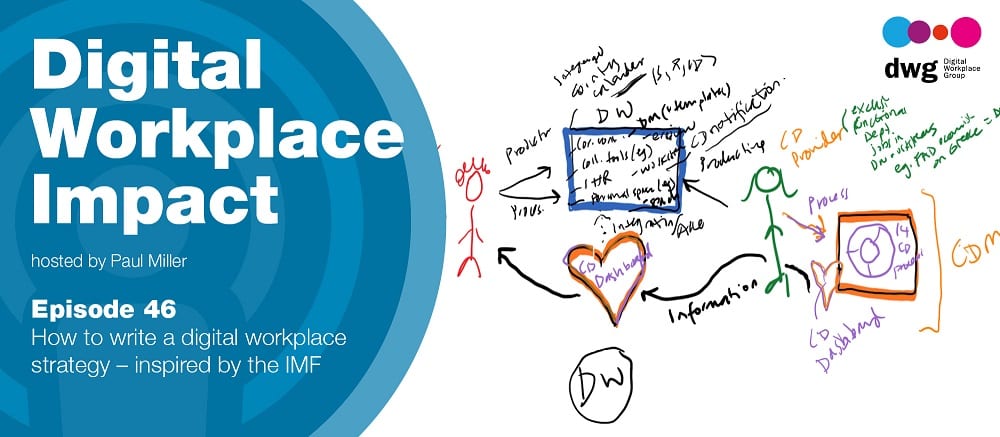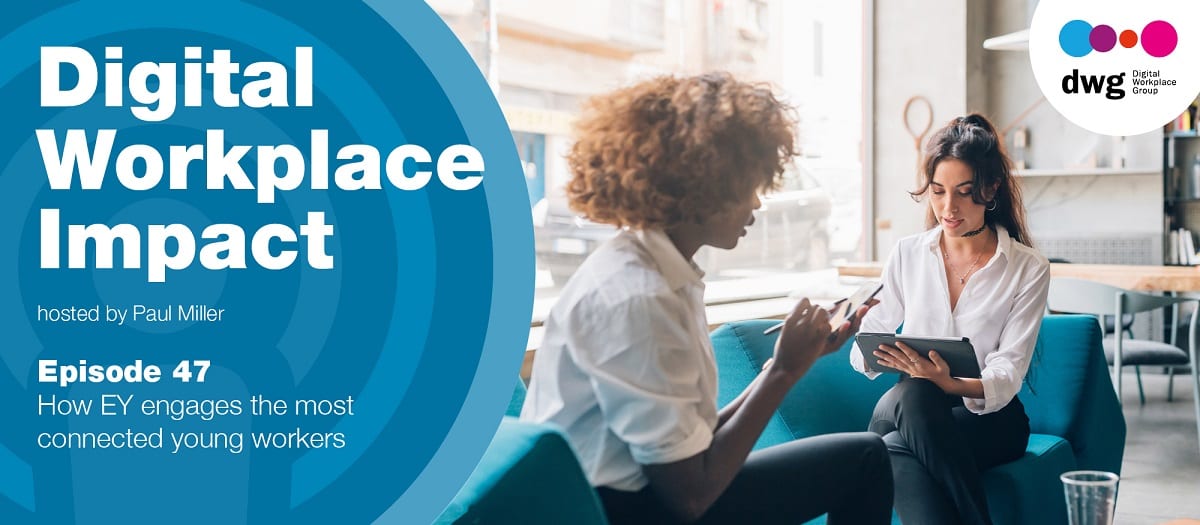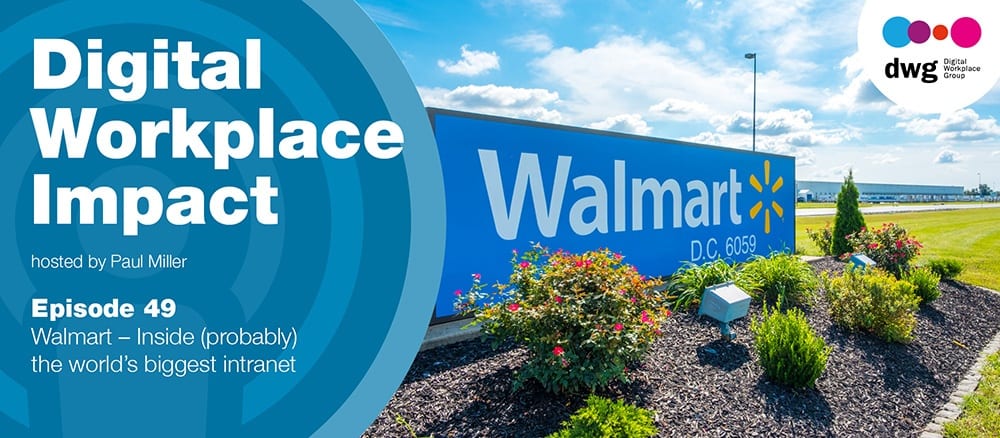Four takeaways from leading digital workplace teams revealed by the Digital Workplace Impact podcast
Insights to help your digital workplace journey
Producing the Digital Workplace Impact podcast means we get to speak to some excellent teams who are at the cutting edge of digital workplace practice. It’s a real pleasure to connect with the early adopters, innovators and leaders in the space.
The motto of Digital Workplace Group is “Don’t journey alone” – and the learnings and insights we collectively gain from speaking to many leading digital workplace practitioners can really help other organizations who are starting out on their own digital workplace journeys. Adding to the body of knowledge in this still emergent field was one of the reasons we started the podcast in the first place. Bearing this in mind, here are four key takeaways from leading digital workplace teams recently revealed in episodes of the Digital Impact podcast.
Episode 46 : How to write a digital workplace strategy – inspired by the IMF
Key takeaway: Brainstorming and whiteboarding can help to articulate and iterate strategy in a way that resonates with stakeholders.

The International Monetary Fund (IMF) is a complex organization, which is staffed by economists and works to foster global economic cooperation across 189 countries. The organization is currently going through a digital transformation programme, establishing a new digital workplace to improve productivity, collaboration and knowledge management. In this interesting session, Paul Miller talks to Nisreen Farhan and Ahmed Ammar from the IMF’s digital workplace team about their work devising and then driving forward a digital workplace strategy.
While the episode covers various interesting topics, including the team’s excellent commitment to driving a robust strategy, for me, the standout takeaway was hearing about the agile brainstorming techniques the team use to rapidly develop and visualize ideas, and then turn these ideas into knowledge assets. Drawing on research and data inputs, the digital workplace team originally took a sketch on Nisreen’s OneNote as a starting point to brainstorm and create a vision for their digital workplace. Repeating this process, they have since regularly held brainstorming sessions, using a whiteboard to sketch out concepts that are often “locked” in people’s heads. The whiteboard visualization offers a fertile format for iterating and developing the ideas unleashed in the brainstorming sessions.
These sketches are then rapidly turned into more formal outputs – usually slides – that illustrate the digital workplace strategy and vision. These slides resonate powerfully with stakeholders and have helped to drive the programme forward, particularly as many of the sketches show the user right at the centre of the digital workplace.
Episode 47: How EY engages the most connected young workers
Key takeaway: Focusing on the needs and expectations of younger employees in turn leads to a focus on user research and associated design techniques.

In Episode 47, Paul spoke to Chase Mohr and Jess Woods from EY about digital natives, product design, user research and a whole range of other fascinating topics. EY is a leading global professional services company and one of the big four accounting firms, offering a range of consulting services. Knowledge management is critical to EY’s client work and the firm has invested heavily in a strong knowledge-driven digital workplace, as well as an effective collaboration platform. It also has a relatively young workplace – in fact, 68% are considered “digital natives”, having grown up in a world where many of today’s digital workplace tools have been in place as long as they remember.
Digital natives and younger generations generally have higher expectations of what digital workplace tools should and can do, for example, expecting tools to work instantly and platforms to already know their online behaviour and preferences. Consequently, EY has adopted a range of approaches to ensure that the digital workplace meets the needs and expectations of younger employees.
What was interesting to hear is just how many of these approaches also cover user research and user-centred design. For example, the company has invested in internal user experience teams who undertake a lot of research, rather than outsourcing this type of work as some other organizations do. They also follow design thinking techniques and product design principles, as well as forming structures such as “sounding board groups” to gain feedback on ideas and designs. Intriguingly, EY has also trained employees to be interviewers themselves, effectively “democratizing” the user research process. Indeed, the higher expectations of digital natives around their experiences of technology means more efforts around user-centred design and research are required. Ultimately, this is benefitting all employees at EY.
Episode 48: Driving Stagecoach to the mobile frontline
Key takeaway: Using employees’ own devices can be a highly effective way to communicate digitally with frontline staff and even advance organizational culture.

Digitally connecting with frontline, mobile and customer-facing staff who are not stationed at desks has always been harder than reaching office-based workers. Thankfully, access to the digital workplace for frontline staff has started to rise in the past couple of years, reducing the “digital disadvantage” they typically experienced in the past. In Episode 48, Paul spoke to Ricky Sickelmore from UK bus operator Stagecoach about how a mobile app from Blink launched to bus drivers and engineers has had a genuinely significant impact.
Stagecoach has around 25,000 staff working across the UK in a relatively decentralized organizational structure. The vast majority of staff work on the frontline and the app is helping them to carry out their jobs more effectively, giving them access to operational information and allowing them to communicate with colleagues while in their vehicles. This can be critical when passing on accurate information to customers, for example.
A major takeaway from this episode is that employees seemed happy to use their own personal mobile phones when it helped them to do their jobs, saved them time and opened up communication with colleagues. Overall, the app has received very good feedback and much higher than expected adoption.
If you’re struggling with digital communications for a mobile workforce, this episode is definitely worth listening to. There are also some great tips for planning a roll-out and launch across a highly distributed workforce.
Episode 49: Walmart – inside (probably) the world’s biggest intranet
Key takeaway: Creating an intranet designed to be experienced outside work and “off the clock” can be a successful strategy.

Walmart is one of the world’s best-known retail brands. It is also absolutely huge – with a staggering 1.5 million workers in the US and an additional 800,000 across the globe, working for different brands such as Asda. This makes up a workforce of 2.5 million people, more than the population of some small countries. In this fascinating episode, Paul talked to Steve Wilson, Director, Digital Strategy & Brand Engagement at Walmart, about managing what is quite possibly the world’s largest intranet.
There are many useful insights in this episode but I was really interested to hear how the current intranet evolved from a platform that initially focused on employees accessing it outside work when they were “off the clock”. At first the site contained mainly HR and benefits information, but then the team continued to expand it, adding some reputational data, then integrating more applications and finally creating a dedicated mobile app accessible from employee-owned devices. All these moves helped drive adoption, although it was the mobile app which tripled or quadrupled daily visits from staff, with over a million staff visiting each month. Even more recently, the “off the clock” intranet has been merged with the operational “on the clock” intranet into one platform, so there is now one true intranet that is also being extended internationally.
For me, this strategy is particularly interesting because it is quite counterintuitive and different from how others have gone about it. Most organizations start with the premise that they want somehow to extend their current intranet or digital workplace experience to frontline staff, rather than beginning by focusing on the needs of those frontline staff who are more easily able to consume information outside work. This approach has certainly worked extremely well for Walmart.
Subscribe to the Digital Workplace Impact podcast
There are many other fascinating episodes of Digital Workplace Impact to explore: browse all of them here. If you don’t want to miss an episode, why not subscribe? You can do so via iTunes, Stitcher Radio and SoundCloud. Happy listening!
Take the next step…
Categorised in: Collaboration, Digital workplace, Metrics & measurement, Strategy & governance

